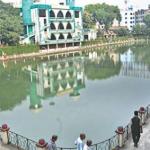Table of contents [Show]
Introduction to Rangpur
Nestled in the northern region of Bangladesh, Rangpur stands as a testament to the country's rich history, vibrant culture, and economic significance. This city, which has undergone several name changes over the years, has evolved into a crucial economic hub, contributing significantly to Bangladesh's growth and development. From its historical roots to its bustling economy, let's delve into the captivating story of Rangpur.

The Evolution of Rangpur: Past Names and Reasons for Change
Rangpur, formerly known as "Carmichael College" and "Carmichael Nagar," has a history woven with change. The city was initially established as a municipality in 1869 and named "Carmichael Nagar" after the British East India Company's chairman, Lord Carmichael. This name was later changed to "Rangpur" in 1895, a nod to the city's vibrant landscape adorned with lush gardens and colorful flowers.
The name change from "Carmichael Nagar" to "Rangpur" marked a shift from colonial nomenclature to a more locally rooted identity. The change reflected the desire to connect the city with its natural surroundings and diverse heritage, fostering a sense of belonging among the local population.

Main Economy of Rangpur: A Catalyst for Bangladesh's Growth
Rangpur's economy serves as a cornerstone for Bangladesh's development. The region boasts an agriculturally driven economy, with agriculture contributing significantly to the country's GDP. The fertile plains and favorable climate make Rangpur a prime area for rice, jute, tea, and tobacco cultivation. The region's strategic importance in agricultural production has earned it the moniker "Rice Bowl of Bangladesh."
Rangpur's economy extends beyond agriculture, with industries such as textiles, ceramics, and agro-processing gaining prominence. The city's well-connected transport network, including roads, railways, and river routes, facilitates the movement of goods, further enhancing its economic prowess.
Rangpur's Role in the Economy of Bangladesh
Rangpur's economic significance extends beyond its immediate borders, playing a pivotal role in Bangladesh's overall economic landscape. The city's agricultural output not only contributes to the nation's food security but also serves as a vital source of export revenue. Bangladesh's jute, rice, and tea exports are significantly bolstered by Rangpur's production, thereby strengthening the nation's international trade position.
Moreover, Rangpur's industrial growth contributes to employment generation and value addition, propelling Bangladesh's journey toward becoming a more diversified and globally competitive economy. The city's infrastructural development, supported by strategic investments, has further facilitated this progress.
Environmental Landscape and Beyond
Rangpur's scenic beauty is not confined to its economic landscapes alone. The region boasts picturesque landscapes, including the Teesta River, serene tea gardens, and expansive rice fields. However, like many places across the globe, Rangpur faces environmental challenges such as deforestation, soil degradation, and water pollution.
Efforts are underway to address these issues and promote sustainable practices. Rangpur's significance as an agricultural powerhouse amplifies the need for responsible land use, water management, and biodiversity conservation. Initiatives aimed at promoting eco-friendly practices, afforestation, and efficient waste management are being pursued to safeguard the region's natural beauty and resources.

Cultural Heritage and Community Harmony
Rangpur's rich cultural heritage is a mosaic of diverse traditions, languages, and customs. The city is home to various ethnic groups, each contributing to its cultural vibrancy. Festivals, fairs, and religious celebrations offer a glimpse into the city's communal harmony and unity.
The historical landmarks and monuments scattered across Rangpur narrate stories of the past, offering insights into its evolution. The Tajhat Palace, for instance, is a testament to the city's architectural heritage and colonial history.
Conclusion
Rangpur stands as a living testament to the dynamic interplay between history, culture, and economics. From its humble beginnings as "Carmichael Nagar" to its evolution as an economic powerhouse, the city has transitioned through time while retaining its cultural heritage and natural beauty. As Bangladesh continues its journey of growth and development, Rangpur's significance remains unwavering, symbolizing the nation's potential, progress, and resilience.








